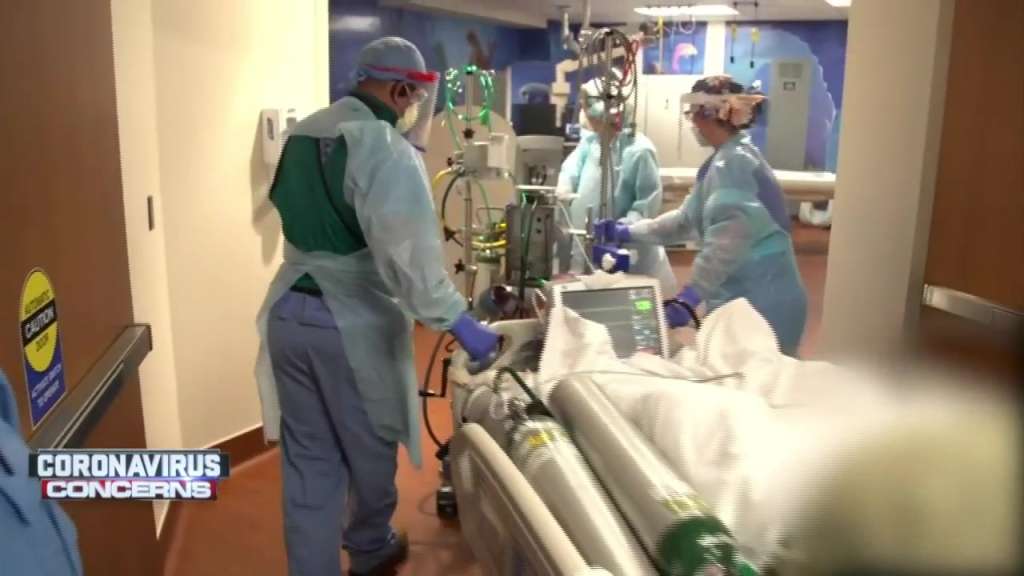Beginning next week, Massachusetts hospitals will start to differentiate between patients they admit primarily for COVID-19 and those admitted to be treated for something else who end up testing positive for COVID-19.
COVID-19 hospitalizations have surged over the last month as the omicron variant has become dominant and the patient count (2,426 patients hospitalized as of Tuesday) is now on par with the peak of the December 2020/January 2021 surge. Meanwhile, hospitals are dealing with staffing shortages that are further stressing the system and limiting bed capacity.
The Department of Public Health said Thursday morning that hospitals will start reporting next week whether admissions are primary or incidental to COVID-19. The update could provide the public with a clearer sense of the severity of the omicron variant and how the record high numbers of new cases correlate to severe illness that requires hospitalization.
DPH’s daily COVID-19 updates provide the number of “patients hospitalized for COVID-19,” but the difference between patients with coronavirus infections serious enough to warrant hospital-level care and patients receiving non-COVID treatment who test positive as part of routine testing at hospitals has been on Gov. Charlie Baker’s mind for more than a year.
“When you call the hospitals and you talk to them one at a time, or the systems, a significant number of the people who they — who we — count as COVID positive are not in the hospital because they have COVID. They’re in the hospital for some other purpose and they got tested positive when they came in,” the governor said on Oct. 1, 2020.
Rep. Jon Santiago, an emergency room doctor at Boston Medical Center, tweeted earlier this week that during a recent stretch of ER shifts a “significant number of my COVID patients fell into 2 buckets: mild symptoms & discharged OR were admitted for non-COVID reasons BUT tested positive for COVID (all admitted patients are tested).”
“Of course, that presents a different set of challenges but the fact that many patients weren’t primarily admitted FOR COVID but rather for other medical issues should add nuance to the ‘COVID hospitalization’ numbers,” Santiago wrote. “This shouldn’t take away from the bed crunch we face, a serious issue already present pre-COVID…”
He said hospitals in Boston and elsewhere are challenged by the number of homeless patients who test positive with mild COVID-19 symptoms and need a place to isolate while they are contagious and by dialysis patients who cannot go to their usual dialysis centers.
“Where do they end up? To the ER they go! To wait for hours (or days!) in a hallway until a precious bed opens up when the VAST majority of these patients don’t have to be in the ER or hospitalized for medical reasons,” he tweeted. “Again, says more about our healthcare system than anything else.”
Despite the stress and strain of the current situation, Santiago said it demonstrates that the COVID-19 vaccines are working as expected.
“Recall that the vaccine’s primary goal was to prevent severe disease – not prevent transmission. Most of us are bound to get COVID but the majority of people will escape severe consequences. And in case you didn’t already know, the unvaccinated folks continue to bear the brunt of severe disease,” he said. “In fact, one can usually correctly guess a patient’s vaccination status while observing their clinical status.”
DPH reported that 93 percent of medical/surgical beds in Massachusetts were occupied as of Tuesday and that 86 percent of intensive care unit beds were occupied, though not all with COVID-19 patients.
Massachusetts hospitals are also contending with a staffing shortage, which has already led the Baker administration to order hospitals to scale back non-emergency procedures if they cannot maintain sufficient capacity. Its impact is clear in the number of total beds reported in DPH’s hospital capacity reports.
One year ago, Massachusetts had 9,254 hospital beds and 1,458 total ICU beds that could be staffed within 24 hours. DPH’s latest hospital capacity update showed a total of 8,775 hospital beds statewide and 1,256 ICU beds — a difference of nearly 700 beds.
New York began this week reporting the breakdown between people hospitalized for COVID-19 and people hospitalized with COVID-19. Gov. Kathy Hochul said Monday that she was “going to start asking some questions” at a critical phase for the state’s hospitals.
“How many people are being hospitalized because of COVID symptoms? How many people are happened to be testing positive just while they’re in there for other treatments? I think that’s important. I just want to always be honest with New Yorkers about how bad this is,” Hochul said, according to a transcript from her office. “Yes, the sheer numbers of people infected are high, but I want to see whether or not the hospitalizations correlate with that. And I’m anticipating to see that at least a certain percentage overall are not related to being treated for COVID.”
(Copyright (c) 2024 State House News Service.

